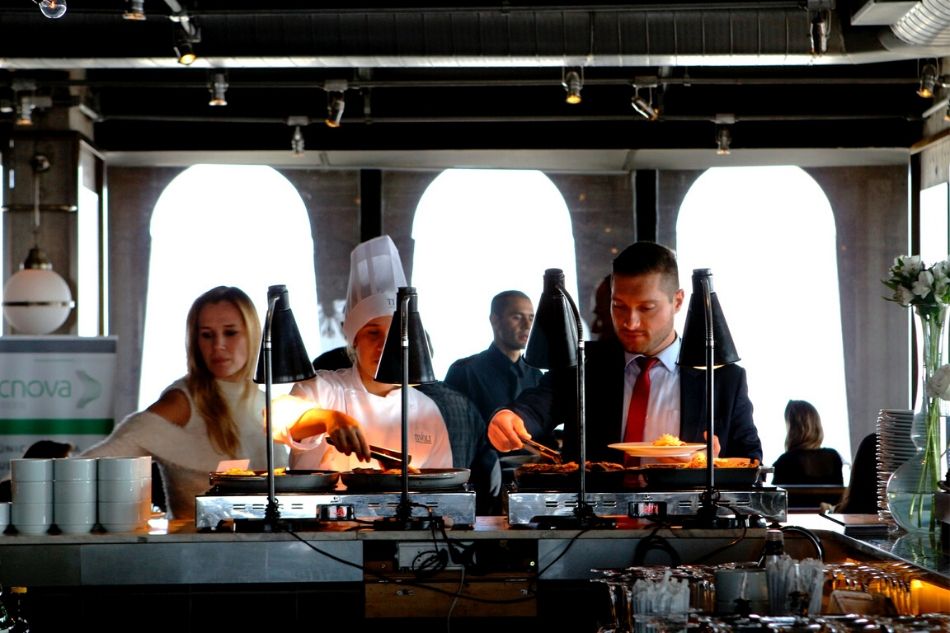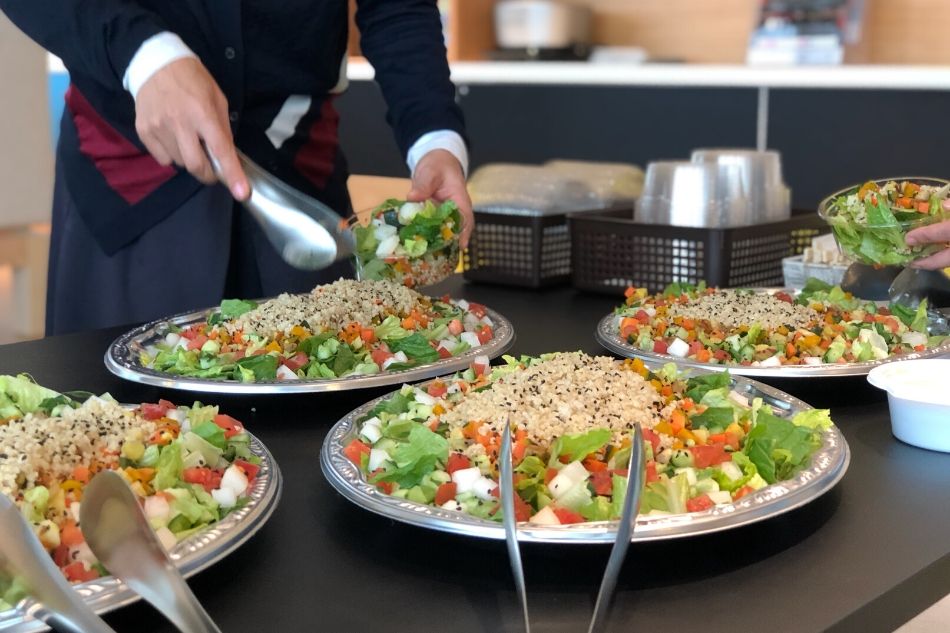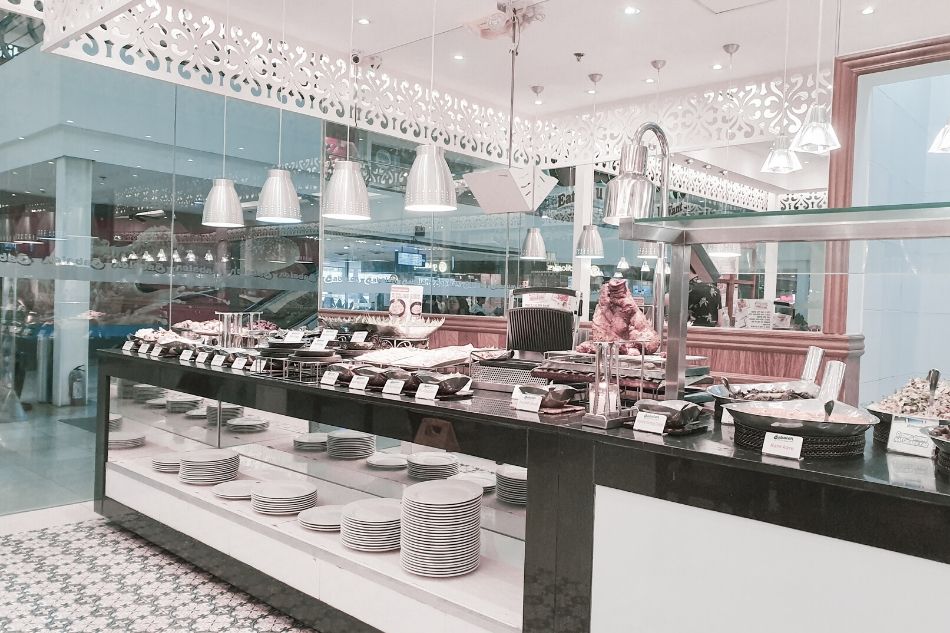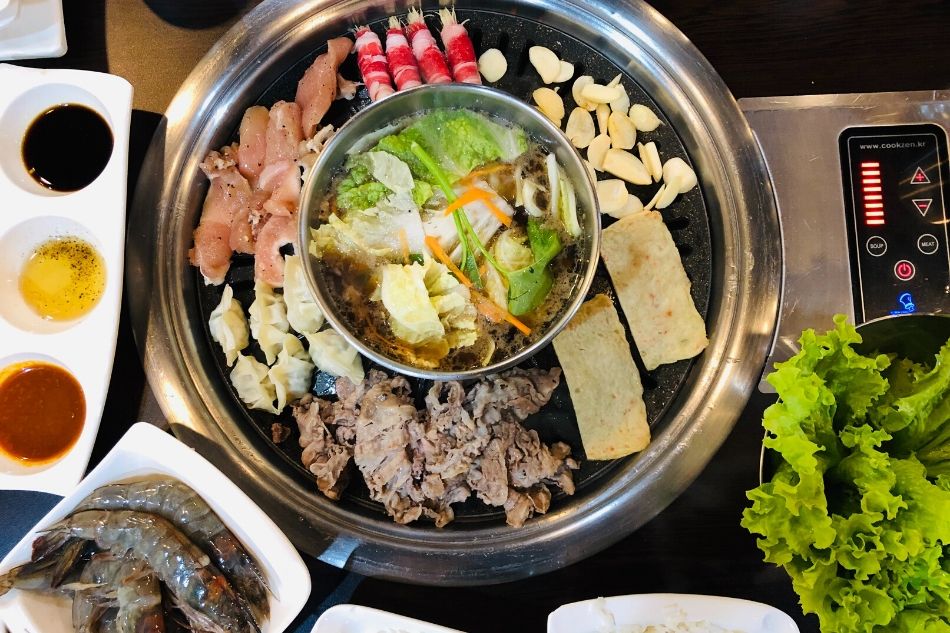Is it safe to dine at buffets? Yes of course—but here’s a list of what you must look out for | ABS-CBN
ADVERTISEMENT

Welcome, Kapamilya! We use cookies to improve your browsing experience. Continuing to use this site means you agree to our use of cookies. Tell me more!
Is it safe to dine at buffets? Yes of course—but here’s a list of what you must look out for
Is it safe to dine at buffets? Yes of course—but here’s a list of what you must look out for
Nana Ozaeta
Published Feb 22, 2020 12:16 PM PHT
|
Updated Feb 22, 2020 12:33 PM PHT
Since news hit about the spread of the dreaded coronavirus (COVID-19) around the world, people have been avoiding crowded areas for fear of contracting the virus and falling ill. Soon enough, a long post began appearing on various chat groups cautioning about the dangers of buffet dining as a possible source of transmission of the virus. It made sense since such a dining set-up involves lots of people walking, talking, and socializing as they serve themselves from the buffet table. So, should people avoid these all-you-can-eat restaurants? The short answer is “no” of course not. But with the resultant panic of the coronavirus outbreak, it’s no surprise that people are wondering about the “what if’s” of transmission through food.
Since news hit about the spread of the dreaded coronavirus (COVID-19) around the world, people have been avoiding crowded areas for fear of contracting the virus and falling ill. Soon enough, a long post began appearing on various chat groups cautioning about the dangers of buffet dining as a possible source of transmission of the virus. It made sense since such a dining set-up involves lots of people walking, talking, and socializing as they serve themselves from the buffet table. So, should people avoid these all-you-can-eat restaurants? The short answer is “no” of course not. But with the resultant panic of the coronavirus outbreak, it’s no surprise that people are wondering about the “what if’s” of transmission through food.
More about Covid-19
More about Covid-19
So can the virus really be transmitted through food? The Food Standards Australia New Zealand (FSANZ) website declares, “Previous experience with outbreaks of illness due to MERS-CoV, SARS-CoV and other respiratory viruses (e.g. avian influenza) suggest that novel coronavirus may have been transmitted from animals to humans.” FSANZ adds, “Transmission through food is unlikely and there is no evidence of this occurring with novel coronavirus to date, however investigations to identify the source of the outbreak, the extent of spread of the infection, and mode(s) of transmission are continuing.”
So can the virus really be transmitted through food? The Food Standards Australia New Zealand (FSANZ) website declares, “Previous experience with outbreaks of illness due to MERS-CoV, SARS-CoV and other respiratory viruses (e.g. avian influenza) suggest that novel coronavirus may have been transmitted from animals to humans.” FSANZ adds, “Transmission through food is unlikely and there is no evidence of this occurring with novel coronavirus to date, however investigations to identify the source of the outbreak, the extent of spread of the infection, and mode(s) of transmission are continuing.”
Reassuring, perhaps, but not quite definitive. Until more is known, it’s up to us consumers to be aware of how possible contamination can happen when dining out, whether it’s the coronavirus or other viruses or bacteria that can lead to illness.
Reassuring, perhaps, but not quite definitive. Until more is known, it’s up to us consumers to be aware of how possible contamination can happen when dining out, whether it’s the coronavirus or other viruses or bacteria that can lead to illness.
ANCX spoke with food safety expert Rommel Sim Gerodias, president of A101 Innovations, Inc. and consultant for Hauptmann Consulting and Business Solutions, to get to the bottom of the “panic” around COVID-19. As a ServSafe Certified Trainer and Proctor, Gerodias takes his job of food safety consultant and auditor seriously, helping restaurant operators develop a proper food safety program. One important part of this is becoming HACCP or Hazard Analysis Critical Control Point compliant, defined by the International HACCP Alliance as “a process control system that identifies where hazards might occur in the food production process and puts into place stringent actions to take to prevent the hazards from occurring. By strictly monitoring and controlling each step of the process, there is less chance for hazards to occur.” Most major food manufacturers, hotels and restaurants, including fast food chains, follow these standards involving “controlling major food risks, such as microbiological, chemical and physical contaminants.”
ANCX spoke with food safety expert Rommel Sim Gerodias, president of A101 Innovations, Inc. and consultant for Hauptmann Consulting and Business Solutions, to get to the bottom of the “panic” around COVID-19. As a ServSafe Certified Trainer and Proctor, Gerodias takes his job of food safety consultant and auditor seriously, helping restaurant operators develop a proper food safety program. One important part of this is becoming HACCP or Hazard Analysis Critical Control Point compliant, defined by the International HACCP Alliance as “a process control system that identifies where hazards might occur in the food production process and puts into place stringent actions to take to prevent the hazards from occurring. By strictly monitoring and controlling each step of the process, there is less chance for hazards to occur.” Most major food manufacturers, hotels and restaurants, including fast food chains, follow these standards involving “controlling major food risks, such as microbiological, chemical and physical contaminants.”
ADVERTISEMENT
When it comes to buffet restaurants, Gerodias agrees that this type of set-up can be susceptible to the transmission of foodborne diseases, especially if customers and staff are careless in handling food. Here, he lists possible practices that “may cause transferring of microorganisms to food”:
When it comes to buffet restaurants, Gerodias agrees that this type of set-up can be susceptible to the transmission of foodborne diseases, especially if customers and staff are careless in handling food. Here, he lists possible practices that “may cause transferring of microorganisms to food”:
-
When guests return to the buffet tables with their used plates and have the serving spoons touch the soiled plates;
-
When guests dip their fingers in foods such as sauces and dressings to taste;
-
When guests use their used eating spoon to get food from the buffet (usually when returning with used plates);
-
When guests sneeze or cough in front of foods in a buffet or in another person’s food;
-
When guests speak, sneeze, or cough in front of the buffet that doesn’t have sneeze guards;
-
When unattended children touch the food with their hands.
-
When guests return to the buffet tables with their used plates and have the serving spoons touch the soiled plates;
-
When guests dip their fingers in foods such as sauces and dressings to taste;
-
When guests use their used eating spoon to get food from the buffet (usually when returning with used plates);
-
When guests sneeze or cough in front of foods in a buffet or in another person’s food;
-
When guests speak, sneeze, or cough in front of the buffet that doesn’t have sneeze guards;
-
When unattended children touch the food with their hands.
Scary, perhaps? And it’s likely that most of us won’t care to admit that we may have done at least one of the above infractions at some point in our lives. But food safety experts are not here to scare diners from dining buffet style. After all, Filipinos love their all-you-can-eat deals and happily indulge for just one set price to pay. Therefore, it’s up to restaurant operators to do what it takes to prevent the possibility of contamination through food, including adding safeguards to gently “discipline” customers to abide by proper food safety practices.
Scary, perhaps? And it’s likely that most of us won’t care to admit that we may have done at least one of the above infractions at some point in our lives. But food safety experts are not here to scare diners from dining buffet style. After all, Filipinos love their all-you-can-eat deals and happily indulge for just one set price to pay. Therefore, it’s up to restaurant operators to do what it takes to prevent the possibility of contamination through food, including adding safeguards to gently “discipline” customers to abide by proper food safety practices.
Gerodias volunteers the following guidelines that he always advises restaurant operators to implement:
Gerodias volunteers the following guidelines that he always advises restaurant operators to implement:
-
Install sneeze guards to protect the buffet tables.
-
Separate raw foods such as sushi and Mongolian barbecue ingredients from cooked or
ready-to-eat foods.
-
Keep serving utensils in the food with the handle sticking out of the food. Utensils may also be kept in an ice water bath, cold running water bath, or water that is maintained at 57°C or higher.
-
Use ice scoops with handles or use tongs to place ice in cups. Keep the handle out of the ice.
-
On buffet tables and self-service areas, make sure that guests return with fresh plates.
-
Watch out for children playing with condiments and dipping their hands in the buffet foods.
-
Require food servers to wash their hands frequently for at least 20 seconds.
-
Provide guests with a properly stocked hand-washing station. After all, the best defense against viruses is proper personal hygiene, starting with hand washing.
-
Install sneeze guards to protect the buffet tables.
-
Separate raw foods such as sushi and Mongolian barbecue ingredients from cooked or
ready-to-eat foods. -
Keep serving utensils in the food with the handle sticking out of the food. Utensils may also be kept in an ice water bath, cold running water bath, or water that is maintained at 57°C or higher.
-
Use ice scoops with handles or use tongs to place ice in cups. Keep the handle out of the ice.
-
On buffet tables and self-service areas, make sure that guests return with fresh plates.
-
Watch out for children playing with condiments and dipping their hands in the buffet foods.
-
Require food servers to wash their hands frequently for at least 20 seconds.
-
Provide guests with a properly stocked hand-washing station. After all, the best defense against viruses is proper personal hygiene, starting with hand washing.
Aside from buffets, another possible cause for concern are the many hotpot, shabu shabu, and Korean BBQ restaurants that have popped up in the metro. While the set-up is different from that of a buffet, what they do serve is a lot of raw meat and seafood that diners then cook themselves at the dining table. Gerodias assures, “If ingredients are properly purchased, received, stored, and served to the guests, there is no significant threat to food safety here.” Again, it’s the establishment’s responsibility to make sure that everything is in order, including how guests handle the food themselves. He shares:
Aside from buffets, another possible cause for concern are the many hotpot, shabu shabu, and Korean BBQ restaurants that have popped up in the metro. While the set-up is different from that of a buffet, what they do serve is a lot of raw meat and seafood that diners then cook themselves at the dining table. Gerodias assures, “If ingredients are properly purchased, received, stored, and served to the guests, there is no significant threat to food safety here.” Again, it’s the establishment’s responsibility to make sure that everything is in order, including how guests handle the food themselves. He shares:
-
Make sure that guests do not let raw food touch food that is cooked already.
-
Use separate utensils for raw and cooked food.
-
Make sure that the food ingredients are evidently cooked before consumption.
-
Make sure that guests do not let raw food touch food that is cooked already.
-
Use separate utensils for raw and cooked food.
-
Make sure that the food ingredients are evidently cooked before consumption.
As a diner entering a buffet-style or cook-it-yourself restaurant, what would be the warning signs to look for that the establishment may not be taking the proper precautions? Gerodias says to observe the following:
As a diner entering a buffet-style or cook-it-yourself restaurant, what would be the warning signs to look for that the establishment may not be taking the proper precautions? Gerodias says to observe the following:
-
If there is no temperature control on the foods being served; hot foods must be kept hot and cold foods must be kept cold;
-
If there are flies and other pests flying around the food and the dining area;
-
If there is no available hand-washing station for guests;
-
If there are no sneeze guards or if the food being served is not properly covered (especially in an outdoors setting);
-
If the toilets are not clean and sanitized, with no soap, hand sanitizers, or other amenities provided;
-
If the food handlers appear sick or appear not to practice proper personal hygiene.
-
If there is no temperature control on the foods being served; hot foods must be kept hot and cold foods must be kept cold;
-
If there are flies and other pests flying around the food and the dining area;
-
If there is no available hand-washing station for guests;
-
If there are no sneeze guards or if the food being served is not properly covered (especially in an outdoors setting);
-
If the toilets are not clean and sanitized, with no soap, hand sanitizers, or other amenities provided;
-
If the food handlers appear sick or appear not to practice proper personal hygiene.
While it may be easy for extra cautious diners to simply say “no” to buffet dining, Gerodias assures that buffets are generally safe. He explains, “Buffet operators are usually trained and aware of food safety guidelines throughout the flow of food. Choose buffet operations that are professionally kept, with a clean and pest-free dining area.” When in doubt, you can always ask the manager to show any food safety certifications that demonstrate, if possible, HACCP compliance.
While it may be easy for extra cautious diners to simply say “no” to buffet dining, Gerodias assures that buffets are generally safe. He explains, “Buffet operators are usually trained and aware of food safety guidelines throughout the flow of food. Choose buffet operations that are professionally kept, with a clean and pest-free dining area.” When in doubt, you can always ask the manager to show any food safety certifications that demonstrate, if possible, HACCP compliance.
Just remember to be pro-active when you’re dining buffet style. Change plates and never reuse them. Don’t be shy about alerting restaurant staff if you see anyone returning to the buffet table with used plates and utensils. And no sneezing, please!
Just remember to be pro-active when you’re dining buffet style. Change plates and never reuse them. Don’t be shy about alerting restaurant staff if you see anyone returning to the buffet table with used plates and utensils. And no sneezing, please!
Read More:
anc
ancx
ancx.ph
food and drink
features
site only
bufftets
covid-19
novel coronavirus
food safety tips
ADVERTISEMENT
ADVERTISEMENT








